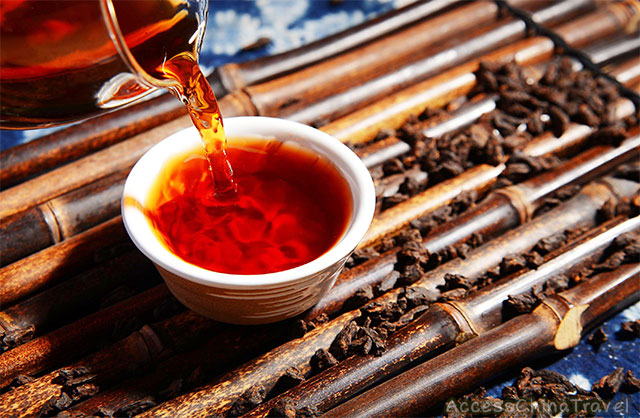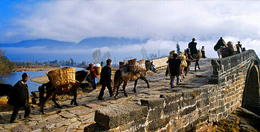
Yunnan Tea

Overview:Top Yunnan tea leaves are Pu-erh Tea, Dian Hong Tea (Yunnan Gold or Red), Nannuo Pekoe(Baihao) Tea, Yunnan Tuocha Tea, Yunnan Green Tea, Qizi Bingcha (Pu'er Tea Cake)....
Yunnan is the southwesternmost province of China. Yunnan is situated in a mountainous area, with high elevations in the northwest and low elevations in the southeast. In the west, the altitude can vary from the mountain peaks to river valleys as much as 3,000 metres (9,800 ft). Yunnan has the largest diversity of plant life (approximately 30,000 species of higher plants) in China. Thus Yunnan is abundant in tea produces.
China is hometown of tea and Yunan its center of tea leaves. A wild tea tree "king" of 3,000 years in Simao in Zhenyuan County and a cultivated tea tree "king" of 800 years in Nannuo Mountain in Menghai County witness a very long history of Yunnan tea leaves and tea culture. Teas grown in Yunnan prior to the Han dynasty (206 BCE-220 CE) were typically produced in a compressed form similar to modern pu-erh tea. Dian hong (Yunnan red or black tea in English) is a relatively new product from Yunnan that began production in the early 20th century. Yunnan also produces green teas, many of which have unique qualities setting them apart from teas produced elsewhere.
Top Famous Yunnan Tea Leaves
1. Pu-erh Tea
Yunnan is best known for Pu-erh tea, a type of fermented dark tea that originated in the Xishuangbanna area and most of counties along Lantsang River and is still produced primarily in the region. Pu'er Tea is named after the old tea trading town of Pu-erh (Puer) and that is produced close by.
Pu'er traditionally begins as a raw product known as "rough tea" and can be sold in this form or pressed into a number of shapes and sold as "raw tea". Both of these forms then undergo the complex process of gradual fermentation and maturation with time. The Wodui fermentation process developed in 1973 by the Kunming Tea Factory created a new type of pu'er tea. This process involves an accelerated fermentation into "ripe tea" which is then stored loose or pressed into various shapes. The fermentation process was adopted at the Menghai Tea Factory shortly after and technically developed there. The legitimacy of "ripe tea" is disputed by some traditionalists in contrast to aged teas. All types of pu'er can be stored to mature before consumption, which is why it is commonly labeled with the year and region of production.
2. Dian Hong Tea (Yunnan Gold or Red)
The province is also known for its Yunnan Gold and other Dianhong teas, developed in Lincang County, Baoshan and Xishuangbanna area in the 20th century. Dian Hong Tea is a type of relatively high-end, gourmet Chinese black tea sometimes used in various tea blends and grown in Yunnan Province. The word Dian is the short name for the Yunnan region while Hong means "red (tea)"; as such, these teas are sometimes simply referred to as Yunnan red or Yunnan black.
The main difference between Dianhong and other Chinese black teas is the amount of fine leaf buds, or "golden tips," present in the dried tea. Dianhong teas produces a brew that is brassy golden orange in colour with a sweet, gentle aroma and no astringency. Cheaper varieties of Dianhong produce a darker brownish brew that can be very bitter.
Once Dian Hong Tea was China's gift for Queen of the United Kingdom.
3. Nannuo Pekoe(Baihao) Tea
Nannuo Baihao Tea is a type of green teas produced in 1981 in Nannuo Mountain situated in Xishuangbanna's eastern Menghai County, a place about 30 kilometers from the prefectural capital, Jinghong. Nannuo Mountain has an elevation of 5,200 feet above sea level and is the site of some of the oldest and largest planted tea trees which grow side by side with the wild plants of the forest. The oldest of these trees is the 800-year-old "King of Tea Trees."
The Hani people and Bulang people live in a village of 560 households. They are descendants of the ancient Qiang people, a nomadic tribe from the Qinghai-Tibet plateau. They are famous in Xishuangbanna for their tea-harvesting and producing abilities.
The mighty mountain, shrouded in mist, is the place where good tea comes from. This old saying contains all it takes to describe one of the oldest tea mountains in Yunnan, a source of the finest raw tea, or maocha, which is used by wise Hani people and Bulang people to make tea of different kinds and shapes.
4. Yunnan Tuocha Tea
Yunnan Tuocha or "dome-shaped bowl tea" is a compressed tea originated in Xiaguan Town, Dali, Yunnan with a history of nearly 100 years, usually made of rough pu-erh and green teas. Among them, Gushu Tuocha is the best one that made of wild old pu-erh tree leaves.
The shape resembles a bird’s nest and tuocha range in weight from 3g to 3kg or more. Tuocha are convex in order to help the tea dry out after processing. The name for tuocha is believed to have originated from the round, top-like shape of the pressed tea or from the old tea shipping and trading route of the Tuojiang River in Dali City. While mini tuocha can be steeped whole, most large tuocha are broken into pieces and only small amounts are steeped at a time.
5. Yunnan Green Tea
Yunnan green tea is mainly grown in the areas of Lincang, Baoshan, Simao, Dehong in Yunnan. Less well known outside of China, but Yunnan green tea has been a staple of Yunnan and Chinese life for decades. The warm tropical and sub-tropical climates that support tea cultivation in Yunnan are numerous and Yunnan produces as much tea as the entirety of the rest of China. Tea can be grown year round but is typically un-plucked during the winter months from the middle of October to late February. The first flush Yunnan green teas are typically harvested in the last week of February just after Chinese New Year. Yunnan green tea varietals are numerous but the vast majority are hybrids based on the "large-leaf" Assamica which is native to Yunnan. The assamica strain lends a great deal of taste, astringency to Yunnan green teas and allows them to be infused several more times than their comparable north-eastern cousin (Dragon Well, Tai Ping Hou Kui or Huang Shan Mao Jian).
6. Qizi Bingcha (Pu'er Tea Cake)
Qizi Bingcha is orginated in Menghai County in Dai Autonomous Prefecture of Xishuangbanna. It literally means "seven sons cake tea". A round flat cake, perfect and complete, and seven cakes in one package that if drank, might produce many sons, and therefore bestow all kinds of blessings and happiness. That is just one popular explanation that has circulated for decades on the origins of the name.
In the seventh year of the reign of the Yongzheng Emperor (1729), Pu’er in southwestern Yunnan, an area that produced tea, salt and minerals in abundance, was renamed Pu’er Prefecture. It became the official tea tribute headquarters of the Qing empire. All the six famous tea mountains in Xishuangbanna, which borders Myanmar to the west and Laos to the south, became "tea-tribute mountains", and of these, tea grown on the tea estates of Mansong village in Yibang, was called ‘a special grade tribute tea’ because of its exceptionally high quality.
Qing civil servants called liuguan replaced the local tusi chieftains in Pu'er Prefecture, and tea, along with other commodities, was designated as tribute or taxes to be sent to the Qing court. Cao Dangzhai, who came from a family of tea traders originally from Sichuan, and grew up the tea estates on Yibang mountain, was appointed military officer of the newly founded Prefecture.
In a memorial sent to the emperor in 1734, Hao Yulin, a high-ranking civil officer in Yunnan requested the emperor to introduce a Tea Law which was officially promulgated the following year.
The Tea Law, among other things, specified that tea must be round and flat, that each cake weighed seven liang (357 grams), and that seven round flat cakes be stacked in dry bamboo leaves called a "tong." It is a practice that has endured well into the twenty-first century.
"Qizi bingcha" was the official name, but it also became synonymous for any round flat Pu'er tea cake. Other similar names circulated: qiziyuan (literally: "seven son's round"), qizibing (literally: "seven son’s cake") and yuancha (literally: "round tea").
While numerous luxury items were sent in tribute to the Qing emperors, including exquisite porcelain from the kilns at Jingdezhen in Jiangxi province, teas, and in particular Pu'er tea, became increasingly popular among the imperial family. Part of its attraction and appeal was that it was tea grown and harvested far away among the ancient growth forests of southwestern Yunnan. It had taken a year and a half to arrive in the capital carried by laden-caravans of horses and mules.
Because of its ability to improve with age, Pu'er tea became known as a "drinkable antique." In the official Qing annals of 1659, it is recorded that Pu'er tea was the tea drunk by the imperial family during the bitter cold winters in the northern capital. The tea cakes were also presented as gifts to visiting foreign envoys and dignitaries as far away as England and Russia.


